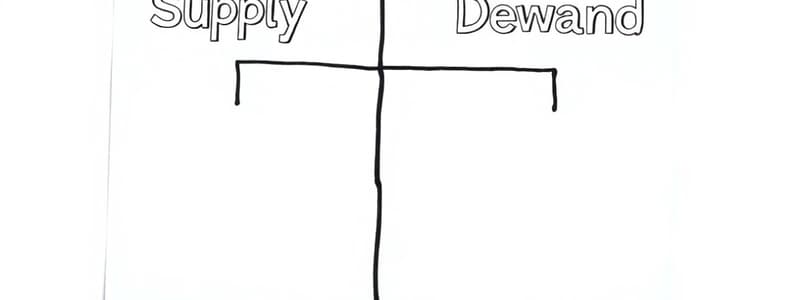Podcast
Questions and Answers
Which statement accurately describes the relationship between fiscal policy and economic activity?
Which statement accurately describes the relationship between fiscal policy and economic activity?
- Fiscal policy has no impact on economic growth.
- Fiscal policy can be used to stimulate economic activity through government spending. (correct)
- Fiscal policy is the same as monetary policy.
- Fiscal policy only affects international trade and not domestic markets.
What characterizes business cycles?
What characterizes business cycles?
- They reflect only long-term economic growth without fluctuations.
- They consist of fluctuations between periods of economic expansion and contraction. (correct)
- They are solely determined by fiscal policy changes.
- They are only defined by periods of economic expansion.
How does international trade influence macroeconomic outcomes?
How does international trade influence macroeconomic outcomes?
- International trade has no effect on exchange rates.
- Exchange rates are entirely determined by fiscal policy.
- It can lead to trade deficits, affecting overall price levels in an economy. (correct)
- International trade only affects domestic unemployment rates.
What is the difference between economic growth and economic development?
What is the difference between economic growth and economic development?
What do aggregate demand and aggregate supply models illustrate?
What do aggregate demand and aggregate supply models illustrate?
What does microeconomics primarily examine?
What does microeconomics primarily examine?
Which market structure is characterized by a single seller controlling the entire market?
Which market structure is characterized by a single seller controlling the entire market?
What is the term for the responsiveness of quantity demanded to changes in price?
What is the term for the responsiveness of quantity demanded to changes in price?
Which concept is used to summarize the total economic output of a country?
Which concept is used to summarize the total economic output of a country?
What is a market failure?
What is a market failure?
What is the primary goal of monetary policy?
What is the primary goal of monetary policy?
Which of the following best describes public goods?
Which of the following best describes public goods?
What does the unemployment rate represent?
What does the unemployment rate represent?
Flashcards
Aggregate Demand
Aggregate Demand
The total demand for goods and services in an economy.
Fiscal Policy
Fiscal Policy
How the government uses taxes and spending to manage the economy.
Monetary Policy
Monetary Policy
How a central bank manages the money supply and credit.
Business Cycles
Business Cycles
Signup and view all the flashcards
Economic Growth
Economic Growth
Signup and view all the flashcards
Microeconomics
Microeconomics
Signup and view all the flashcards
Macroeconomics
Macroeconomics
Signup and view all the flashcards
Supply and Demand
Supply and Demand
Signup and view all the flashcards
Market Equilibrium
Market Equilibrium
Signup and view all the flashcards
Gross Domestic Product (GDP)
Gross Domestic Product (GDP)
Signup and view all the flashcards
Inflation
Inflation
Signup and view all the flashcards
Unemployment
Unemployment
Signup and view all the flashcards
Market Failure
Market Failure
Signup and view all the flashcards
Study Notes
Economics
- Economics is the social science that studies how societies allocate scarce resources to satisfy unlimited wants and needs.
- It's divided into two major branches: microeconomics and macroeconomics.
Microeconomics
- Microeconomics focuses on the behavior of individual economic agents, such as households and firms.
- It examines how these agents make decisions in the face of scarcity and how their decisions interact in specific markets.
- Key concepts include supply and demand, market equilibrium, elasticity, production costs, market structures (perfect competition, monopoly, oligopoly, monopolistic competition), and consumer choice theory.
- Supply and demand determine the price and quantity of goods and services in a market.
- Elasticity measures the responsiveness of quantity demanded or supplied to changes in price or other factors.
- Production costs are the expenses incurred by firms to produce goods and services.
- Market structures describe the characteristics of markets based on the number and size of firms.
- Consumer choice theory examines how consumers make decisions to maximize their utility.
- Externalities, like pollution, can affect the efficiency of markets and lead to market failures.
- Market failures are situations where markets fail to allocate resources efficiently.
- Public goods, like national defense, are goods that are non-excludable and non-rivalrous, hence, often requiring government intervention.
- Governments use policies like taxes, subsidies, and regulations to influence market outcomes.
Macroeconomics
- Macroeconomics studies the behavior of the entire economy, including aggregate variables such as inflation, unemployment, and economic growth.
- It examines the interactions between different sectors of the economy, such as households, firms, and governments.
- Macroeconomic objectives include promoting economic growth, reducing unemployment, and controlling inflation.
- Key macroeconomic concepts include Gross Domestic Product (GDP), inflation rate, unemployment rate, aggregate demand and aggregate supply, fiscal policy, and monetary policy.
- GDP measures the total value of goods and services produced in an economy over a period of time.
- Inflation is a general increase in the overall price level of goods and services.
- Unemployment refers to the percentage of the labor force that is actively seeking employment but unable to find it.
- Aggregate demand and aggregate supply are models that visualize how total supply and demand from all market sectors in an economy influence the overall price and output levels.
- Fiscal policy refers to the government's use of taxation and spending to influence the economy.
- Monetary policy refers to the actions taken by the central bank to influence the amount of money and credit in the economy.
- Business cycles are fluctuations in economic activity characterized by periods of expansion and contraction.
- Economic growth refers to an increase in the production of goods and services in an economy over time.
- International trade and exchange rates are crucial factors in macroeconomics; they heavily influence price levels and can lead to trade deficits or surpluses.
- Economic development is a broader concept than economic growth, including factors like poverty reduction and improving living standards.
Studying That Suits You
Use AI to generate personalized quizzes and flashcards to suit your learning preferences.




